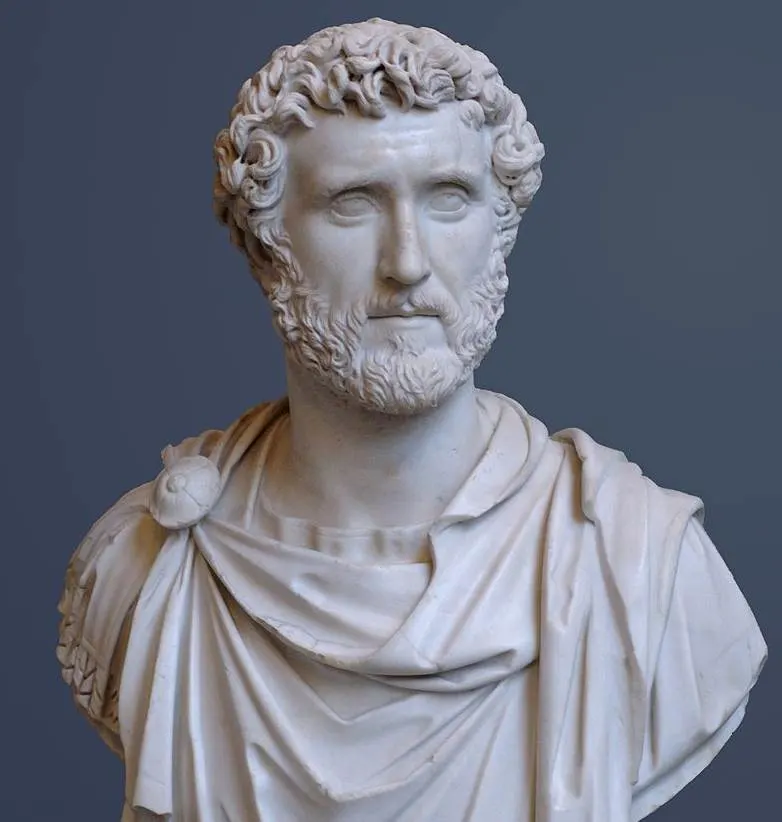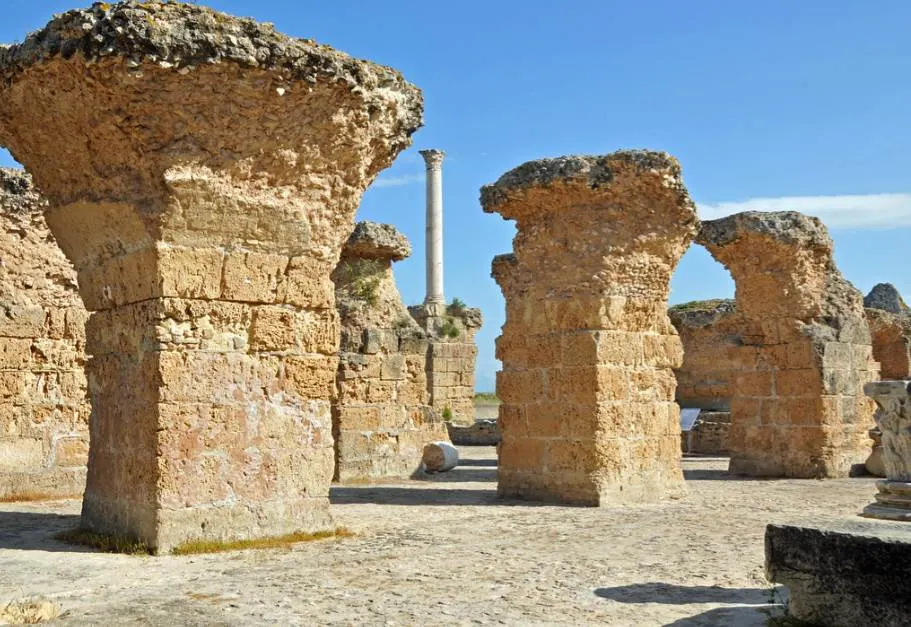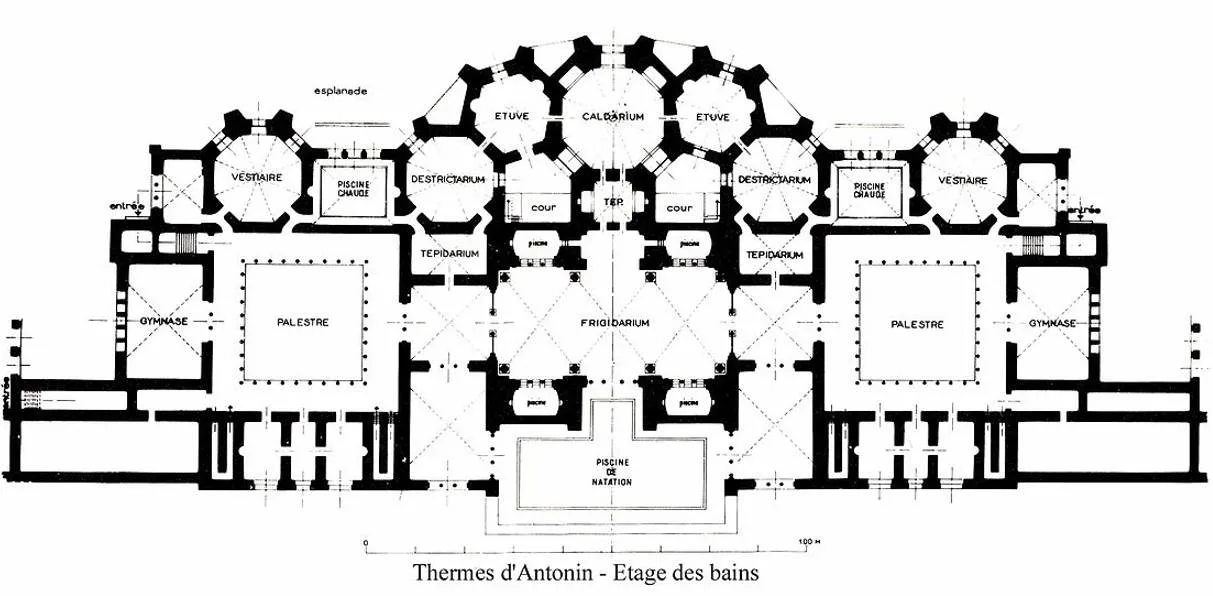The Roman Empire was vast at its peak and included all of southern Europe, Eastern Europe, and as far as Mesopotamia in modern-day Iraq.
It also encompassed all of North Africa, a section of the empire that featured some of its largest cities such as Alexandria and Carthage.
They built large structures in the form of Roman temples, forums, Roman amphitheaters, and Roman bathhouses.
In this article, you’ll discover some of the most interesting facts about the Baths of Antoninus, one of the largest bathhouse complexes ever constructed.
1. They are located in Carthage just east of the capital of Tunisia
The Baths of Antoninus are a ruined, yet very intriguing ancient Roman bathing complex in Tunisia. They are located in Carthage, the ancient city that lies in ruins today.
Carthage is situated just northeast of the Lake of Tunis which is in turn just east of the modern-day city of Tunis.
Tunis is a major city situated don’t the Gulf of Tunis which is part of the Mediterranean Sea. This is in the utmost northern part of the country.
The city has grown significantly in the past couple of decades and is home to over 2.7 million inhabitants. This makes it the third-largest city in the Maghreb region after Casablanca and Algiers.

2. The baths were named for a 2nd-century Roman Emperor
The large bathing complex was constructed in the 2nd century A.D. during the reign of Roman Emperor Antoninus Pius (86-161 A.D.).

This was a relatively good period of the Roman Empire and he was considered to be one of the so-called “Five Good Emperors.”
It has to be said, the not-so-good emperors were abundant during the first couple of centuries A.D. so we can take this title with a grain of salt.
Antoninus Pius was married to Faustian, the niece of Roman Emperor Hadrian. Hadrian made him his adopted son through which he was able to succeed his stepfather in the Empire’s highest position. He ruled between 138 and 161.

3. It took about 17 years before the baths were completed
Carthage was the capital city of the ancient Carthaginian civilization. The Punic Empire, as it is also referred to, was one of the most powerful in the area before Rome started expanding.
The Punic Wars spanned multiple centuries and the Third Punic War between 149 and 146 B.C. made an end to the once-powerful empire.
The Roans constructed a completely new city on top of the destroyed city of Carthage and a bathing complex was built in order to appease the local population.
Public baths were one of the most popular entertainment venues in ancient Rome and the number one spot for the population to socialize.
It took about 17 years before the Baths of Antoninus were completed as they were constructed between 145 and 162 A.D.

4. The complex is part of a much larger archaeological site
Carthage was an advanced city that was founded by the Phoenicians in the 9th century B.C. It grew from a small settlement to one of the most important trading centers in North Africa.
It didn’t lose its importance when the Romans finally conquered it in the 2nd century B.C., regardless of the fact that the ancient city was just about completely destroyed during the Third Punic War.
The ruins of Carthage we can still admire today are the remains of the buildings here constructed by the Romans in the province they referred to as Africa.
The bathing complex was constructed in the southeastern part of the city and is part of the much larger archaeological park. The first excavations of this site took place shortly after World War II.
5. The Baths of Antoninus hold some remarkable records
The Romans just about erased the entire history of the Carthagenian EMpire after the bloody Third Pubic War. They killed all inhabitants except for the 50,000 people they sold into slavery on the final day.
They also destroyed the texts that could have shed some light on the way of living in ancient Carthage before the Romans arrived.
Because of this extensive conflict, the Romans wanted to make a statement. Many of the buildings they constructed were some of the largest buildings in the Roman Empire, including the Baths of Antoninus.
This bathing complex as the third-largest ever constructed in the Roman Empire and the largest outside of Italy. Only the Baths of Caracalla and the Baths of Diocletian, both incredible landmarks in Rome, were bigger.

6. The floor plan of the complex shows just how immense this facility was
The Baths of Antoninus were huge, and that’s an understatement. You especially need to consider the fact that these people didn’t have modern machinery to move and put these immense stones into place.
It’s believed that they had a length of up to 300 meters (984 feet), were supported by pillars of 15 meters (49 feet) (of which one remains as you can see above), and arches that reached a height of 30 meters (98 feet).
The complex consisted of the usual cold, lukewarm, and hot rooms, and also featured 2 gymnasiums and two large swimming pools. The floor plan makes clear how big this entertainment complex really was.

7. It became part of a UNESCO World Heritage site in 1979
Carthage has been an archaeological treasure cover ever since excavations started in the years following the conclusion of WWII.
This notion has resulted in the archaeological park that was established here to be one of the first complexes to be listed as a UNESCO World Heritage site.
The ruins of Carthage, including its baths, were designated as such in 1979 which was only the third session of the World Heritage Committee.

8. One of the most important buildings in Tunisia is located just north
There are nearly 3,000 years between the foundation of Carthage and the modern-day government of Tunisia, and both civilizations come together here.
The Baths of Antoninus are located just south of the Carthage Palace, the official seat and residence of the President of Tunisia.
The palace was completed between 1960 and 1969 and is located in a magnificent location along the Mediterranean Sea, just like the ancient buildings nearby.

